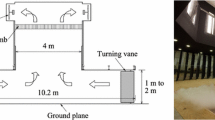Abstract
Within the wind engineering community, a series of physical simulators of differing geometries have been used to investigate the flow-field of tornado-like vortices. This paper examines the influence that the geometry of a simulator can have on the generated flow field. Surface pressure and velocity data have been measured for two swirl ratios (S = 0.30 and S = 0.69) in two different simulators of different scale and varying geometry. The results of this research suggest that far from being a mature research field, there are still many unresolved questions that need to be addressed before data obtained from such simulators can be used with confidence in practice.







Similar content being viewed by others
References
Solari G, Rainisio D, De Gaetano P (2017) Hybrid simulation of thunderstorm outflows and wind-excited response of structures. Meccanica 52:3197–3220. https://doi.org/10.1007/s11012-017-0718-x
Brusco S, Lerzo V, Solari G (2019) Directional response of structures to thunderstorm outflows. Meccanica. https://doi.org/10.1007/s11012-019-00986-5
Jesson M, Lombardo FT, Sterling M, Baker CJ (2019) The physical simulation of a transient, downburst-like event—how complex does it need to be? J Wind Eng Ind Aerodyn 189:135–150. https://doi.org/10.1016/j.jweia.2019.03.021
Letchford CW, Mans C, Chay MT (2002) Thunderstorms—their importance in windengineering (a case for the next generation wind tunnel). J Wind Eng Ind Aerodyn 90:1415–1433. https://doi.org/10.1016/S0167-6105(02)00262-3
NOAA (2011) National Oceanic and Atmospheric Administration—U.S. Department of Commerce. https://www.ncdc.noaa.gov/sotc/tornadoes/201113. Accessed 6 June 2018
Hoecker WH (1960) Wind speed and air flow patterns in the Dallas tornado of April 2, 1957. Mon Weather Rev 88:167–180. https://doi.org/10.1175/1520-0493(1960)088<0167:WSAAFP>2.0.CO;2
Winn WP, Hunyady SJ, Aulich GD (1999) Pressure at the ground in a large tornado. J Geophys Res Atmos 104:22067–22082. https://doi.org/10.1029/1999JD900387
Wurman J, Gill S (2000) Finescale radar observations of the Dimmitt, Texas (2 June 1995), tornado. Mon Weather Rev 128:2135–2164. https://doi.org/10.1175/1520-0493(2000)128<2135:FROOTD>2.0.CO;2
Lee J, Samaras T, Young CR (2004) Pressure measurements at the ground in an F-4 tornado. In: The 22nd conference on severe local storms, Anonymous Hyannis, MA
Wurman J, Alexander CR (2004) The 30 May 1998 Spencer, South Dakota, Storm. Part II: comparison of observed damage and radar-derived winds in the tornadoes. Mon Weather Rev 133:97–119. https://doi.org/10.1175/MWR-2856.1
Lee WC, Wurman J (2005) Diagnosed three-dimensional axisymmetric structure of the Mulhall tornado on 3 May 1999. J Atmos Sci 62:2373–2393. https://doi.org/10.1175/JAS3489.1
Karstens CD, Samaras TM, Lee BD, Gallus WA Jr, Finley CA (2010) Near-ground pressure and wind measurements in tornadoes. Mon Weather Rev 138:2570–2588. https://doi.org/10.1175/2010MWR3201.1
Kosiba K, Wurman J (2010) The three-dimensional axisymmetric wind field structure of the Spencer, South Dakota, 1998 tornado. J Atmos Sci 67:3074–3083. https://doi.org/10.1175/2010JAS3416.1
Wurman J, Kosiba K, Robinson P (2013) In situ, Doppler radar, and video observations of the interior structure of a tornado and the wind-damage relationship. Bull Am Meteorol Soc 94:835–846. https://doi.org/10.1175/BAMS-D-12-00114.1
Refan M, Hangan H, Wurman J, Kosiba K (2017) Doppler radar-derived wind field of five tornado events with application to engineering simulations. Eng Struct 148:509–521. https://doi.org/10.1016/j.engstruct.2017.06.068
Ward NB (1972) The exploration of certain features of tornado dynamics using a laboratory model. J Atmos Sci 29:1194–1204. https://doi.org/10.1175/1520-0469(1972)029<1194:TEOCFO>2.0.CO;2
Church CR, Snow JT, Baker GL, Agee EM (1979) Characteristics of tornado-like vortices as a function of Swirl ratio: a laboratory investigation. J Atmos Sci 36:1755–1776. https://doi.org/10.1175/1520-0469(1979)036<1755:COTLVA>2.0.CO;2
Haan FL Jr, Sarkar PP, Gallus WA (2008) Design, construction and performance of a large tornado simulator for wind engineering applications. Eng Struct 30:1146–1159. https://doi.org/10.1016/j.engstruct.2007.07.010
Mishra AR, James DL, Letchford CW (2008) Physical simulation of a single-celled tornado-like vortex, part A: flow field characterization. J Wind Eng Ind Aerodyn 96:1243–1257. https://doi.org/10.1016/j.jweia.2008.02.063
Sabareesh GR, Matsui M, Tamura Y (2012) Dependence of surface pressures on a cubic building in tornado like flow on building location and ground roughness. J Wind Eng Ind Aerodyn 103:50–59. https://doi.org/10.1016/j.jweia.2012.02.011
Refan M, Hangan H (2016) Characterization of tornado-like flow fields in a new model scale wind testing chamber. J Wind Eng Ind Aerodyn 151:107–121. https://doi.org/10.1016/j.jweia.2016.02.002
Refan M, Hangan H (2018) Near surface experimental exploration of tornado vortices. J Wind Eng Ind Aerodyn 175:120–135. https://doi.org/10.1016/j.jweia.2018.01.042
Gillmeier S, Sterling M, Hemida H, Baker CJ (2018) A reflection on analytical tornado-like vortex flow field models. J Wind Eng Ind Aerodyn 174:10–27. https://doi.org/10.1016/j.jweia.2017.12.017
Tang Z, Feng C, Wu L, Zuo D, James DL (2018) Characteristics of tornado-like vortices simulated in a large-scale ward-type simulator. Bound Layer Meteorol 166:327–350. https://doi.org/10.1007/s10546-017-0305-7
Davies-Jones RP (1973) The dependence of core radius on swirl ratio in a tornado simulator. J Atmos Sci 30:1427–1430. https://doi.org/10.1175/1520-0469(1973)030<1427:TDOCRO>2.0.CO;2
Tang Z, Zuo D, James D, Eguchi Y, Hattori Y (2018) Effects of aspect ratio on laboratory simulation of tornado-like vortices. Wind Struct 27:111–121. https://doi.org/10.12989/was.2018.27.2.111
Wan CA, Chang CC (1972) Measurement of the velocity field in a simulated tornado-like vortex using a three-dimensional velocity probe. J Atmos Sci 29:116–127. https://doi.org/10.1175/1520-0469(1972)029<0116:MOTVFI>2.0.CO;2
Jischke MC, Parang M (1974) Properties of simulated tornado-like vortices. J Atmos Sci 11:506–512. https://doi.org/10.1175/1520-0469(1974)031%3C0506:POSTLV%3E2.0.CO;2
Zhang W, Sarkar PP (2012) Near-ground tornado-like vortex structure resolved by particle image velocimetry (PIV). Exp Fluids 52:479–493. https://doi.org/10.1007/s00348-011-1229-5
Hashemi-Tari P, Gurka R, Hangan H (2010) Experimental investigation of tornado-like vortex dynamics with swirl ratio: the mean and turbulent flow fields. J Wind Eng Ind Aerodyn 98:936–944. https://doi.org/10.1016/j.jweia.2010.10.001
Gillmeier S, Sterling M, Baker C (2017) An analysis of non-stationary processes in tornado-like vortices. In: International workshop on physical modelling of flow and dispersion phenomena. France
Church CR, Snow JT, Agee EM (1977) Tornado vortex simulation at Purdue University. Am Metrol Soc 58:900–908. https://doi.org/10.1175/1520-0477(1977)058<0900:TVSAPU>2.0.CO;2
Author information
Authors and Affiliations
Corresponding author
Ethics declarations
Conflict of interest
The authors declare that they have no conflict of interest.
Additional information
Publisher's Note
Springer Nature remains neutral with regard to jurisdictional claims in published maps and institutional affiliations.
Rights and permissions
About this article
Cite this article
Gillmeier, S., Sterling, M. & Hemida, H. Simulating tornado-like flows: the effect of the simulator’s geometry. Meccanica 54, 2385–2398 (2019). https://doi.org/10.1007/s11012-019-01082-4
Received:
Accepted:
Published:
Issue Date:
DOI: https://doi.org/10.1007/s11012-019-01082-4




